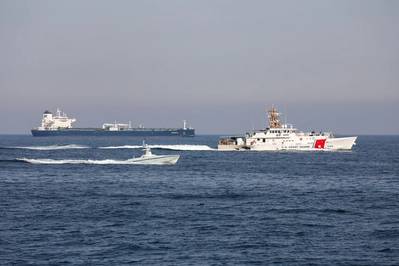US Navy Sends a USV Through the Strait of Hormuz
The U.S. Navy on Wednesday sent an uncrewed surface vessel (USV) through the Strait of Hormuz as it ramps up its use of high-tech unmanned assets for patrols and monitoring at sea.
The transit was reportedly the Navy's fist for a USV through the busy and strategically important strait, demonstrating the continued operational integration of unmanned and artificial intelligence systems by U.S. maritime forces in the Middle East.
The L3 Harris Arabian Fox MAST-13 USV was accompanied by a pair of Sentinel-class Coast Guard cutters, USCGC Charles Moulthrope (WPC 1141) and USCGC John Scheuerman (WPC 1146), sailing south from the Arabian Gulf through the Strait of Hormuz before entering the Gulf of Oman. The vessels are operating in support of the International Maritime Security Construct, an 11-nation coalition led by the United States that focuses on maritime operations near key waterways in the Middle East.
The first-of-its-kind transit drew the attention of Iran, but was completed without incident, Navy spokesman Cmdr. Timothy Hawkins told The Associated Press. “The Iranians observed the unmanned surface vessel transiting the strait in accordance with international law,” Hawkins told AP, adding that an Iranian drone and at least one Houdong-class fast-attack vessel operated by Iran’s Revolutionary Guard observed the MAST-13 USV.
The Navy' 5th Fleet in September 2021 established Task Force 59 to integrate unmanned systems and artificial intelligence into regional maritime operations. Since its launch, the unit has deployed a suite of new uncrewed systems, including surface and aerial, from operational hubs in Jordan and Bahrain.
“We are on the cutting-edge of integrating advanced unmanned technology into our maritime patrols. Our crews are excited to help lead these efforts with our Navy counterparts,” said Lt. Cmdr. Stephen Hills, Charles Moulthrope’s commanding officer.
The 5th Fleet is leading regional efforts to increase vigilance in surrounding waters that include more than 5,000 miles of coastline from the Suez Canal, around the Arabian Peninsula, through the Strait of Hormuz and into the Arabian Gulf. The integration of unmanned platforms and sensors alongside crewed ships from the United States and regional partners enhances this capability.











